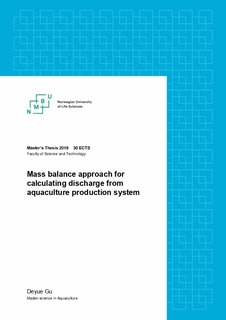| dc.description.abstract | Recirculation aquaculture system (RAS) is widely used in salmon farming because of the high biomass outcome. Besides, it also minimizes the ecological impact through nutrient recycling and by reducing the discharge of waste water into the environment. Atlantic salmon is the dominating species in Norwegian aquaculture, and the sustainability of the salmon farming industry has been questioned. There are some indicators and methods used for measuring sustainability and eco-efficiency of aquaculture productions. For example, the simple fish-in-fish-out-ratio, different kinds of nutrient retention rates, energy retention rate, marine nutrient dependency ratio and forage fish dependency ratio. The energy retention rate has developed as a method to measure the energy efficiency of salmon production.
Therefore, this study is mainly focused on elements (carbon, nitrogen, phosphorous), nutrients (protein, fat, caebohydrate) and energy budget in the overflow of the salmon production system. The retention rates are calculated by using the typical salmon feed composition and typical salmon composition. In the end, a salmon mass balance model was made to better understand the efficiency of the salmon farming industry.
Based on the typical salmon feed composition and typical salmon composition, the result showed that the retention rate of C, N and P were 45%, 36% and 16%, respectively. For protein, fat and caebohydrate it was 40%, 93% and 8%, respectively. And for energy, it was 60%. In addition, the dry matter retention rate was 38%. | nb_NO |

